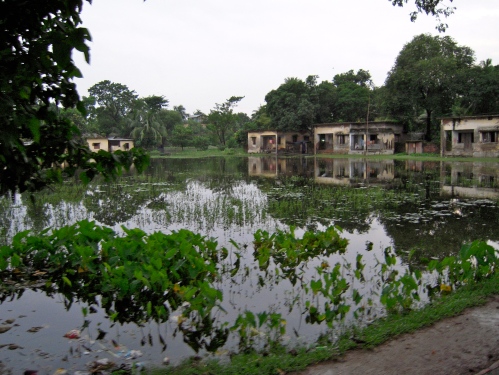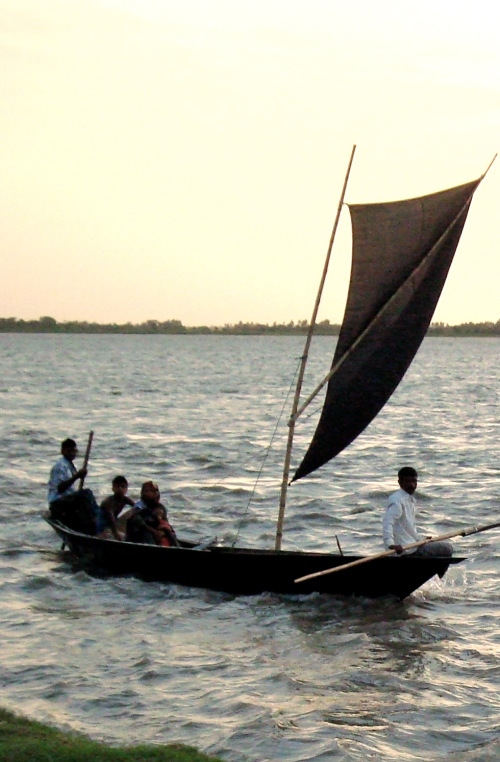*August 16, 2011
The boat carried us through the smooth water, to our last char, Kharjani Char. The char is relatively new, only about two and a half years old. Because of this, a permanent FCM hasn’t been assigned to this char of approximately 85 houses and over 700 people above the age of 18.
However, we picked up an FCM from a nearby char to join our crew of health manager, paramedic, translator, and Sareeta Apa on the boat. The FCM would aid the paramedic and conduct the uthan boitak (health meeting) today.
The clinic, a small shack with a side of reed, was only half-full when we arrived. There was a baby on the ground in the front, playing with a piece of trash. A small boy ran past me, brushing past my legs. On his chest, there was a burn mark extending the length of his bottom rib, to match the red color of his shorts.
Later, as I sat with my checklist at the uthan boitak, watching the FCM show women family planning posters, I noticed an old woman about five feet in front of me. She had a kind face, but worn with years, unhappiness deeply planted in her eyes. Protruding from her orange sari, below her chin, was a lump, bigger than the size of my fist.
I leaned over to Sareeta Apa, and asked her if she was here to get it checked out. After the meeting, as patients waited in line to be seen, Sareeta Apa asked. The patient was at the satellite clinic to seek care for headaches, not for the tumor, as she had already been living with the condition for more than three years. Can you imagine? Three years without medical support.
I asked her, through my translator, if she had any pain or trouble swallowing. She had none. But if it had grown to this size in 3 years, there was no telling when it would reach the point of obstructing her esophagus or larynx. The health manager intervened, telling the patient that we had a hospital where a simple surgery could fix her problem.
She was insistent, shaking her head from side to side. She also said she didn’t have the money to access the boat anyway. As she said this, the two or three young couples who had surrounded us to watch the situation unfold started laughing. I asked what was so funny, and the health manager answered, with a frown, that people were telling the patient she shouldn’t seek treatment because they’ll cut her open and she’ll die on the table. She’s old anyway, there’s no need to spend resources to fix her. Besides, it’s a curse from Allah. There’s nothing we can do to fix it.
I felt my cheeks get red. The discouragement from her fellow community members made her flee the scene as soon as she got her medicine for headaches. She had two sons who kept their distance, I was told. Additionally, I was informed that if she had daughters instead, they would be oppressed and ousted by the community, just like their mother.
Two things were at play here: 1) the fear and social taboo surrounding getting medical treatment in the form of an operation, and 2) cultural beliefs that the sickness was Allah’s will, and that’s it. Both are things that can be addressed with medical treatment coupled with educational outreach. It’s hard for communities to disprove the legitimacy of such operations and treatments once they see their neighbors healed. The hard part is getting those neighbors to get treated in the first place.
What a last visit. I don’t remember feeling this sad, disappointed, and hopeless in a long time. But one thing is for sure – this brought home for me the vitality of having services in communities in addition to our hospital boats. We can create all the hospitals we want – in planes, boats, buses – but if these health facilities are not used by those that they are geared to heal, then our work is wasted. Uthan boitak, our community health meetings, can be used for adding the roots needed to get these patients to view their health in an empowering way. The capacity is there, we just need to scale up, focus, and fortify.
I head home tomorrow morning. The bus will be a good time to process some of these thoughts and transform them into something positive – namely, a rant on the importance of community outreach in my internship report. I should have plenty of time, as bus strikes have gripped the nation by storm right before Eid.















